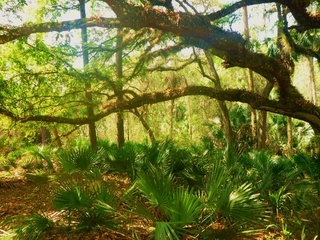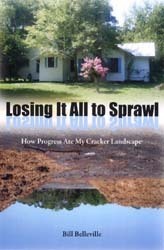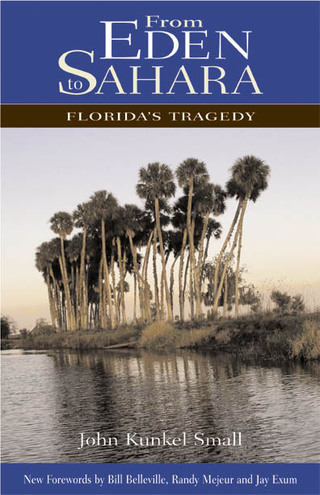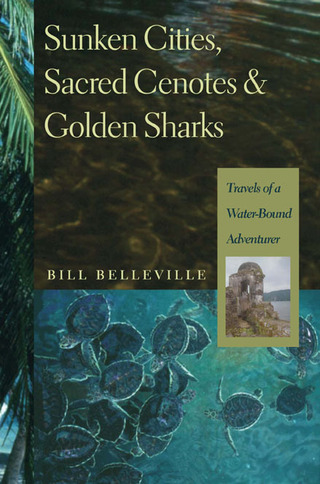WELCOME TO MY WORLD....
This is what I love about wild places in Florida---visions that could be from a few weeks ago, or a few centuries. This is a wonderfully time-stuck scene of an ancient live oak sprawling out atop a clutch of young sabal palms somewhere inside the vast Seminole State Forest. (To enlarge the image, simply click on it.)
Lots of critters depend on protected habitats like this for food and water and shelter---from black bears to rare wading birds---just as they have for thousands of years. The 32 square mile Forest is part of the surrounding Wekiva River basin---which is home to some of the greatest biological diversity of plants and animals in all of Florida.
These wild places are among my favorite places to go and, if I'm lucky, to participate in the dialogue between wilderness and the human spirit.
Fortunately, a dialogue like can still be found in Florida wherever our intact ecological systems still endure---the coastal lagoons, the un-roaded Keys, the offshore reefs---any real place where the sweet and noble force of nature has the energy to sing its hymn of comfort and light.
Our forthcoming PBS film for Equinox Documentaries has to do with our Florida springs and how they've shaped our landscape---and our culture---through time. For more about it, click on the link under "View Our New Springs Film Trailer" at the column on the left.
OTHERWISE...
I MAKE MY LIVING as a nonfiction writer specializing in nature and conservation. I've authored six books, contributed to eight national anthologies, written over 1,000 articles & essays, scripted and co-produced seven films. On assignment, I've traveled to Australia, the White Sea of Russia, the Galapagos, Central and South America, Cuba and throughout the Antilles. Florida, where I live, remains my favorite place for its natural diversity and wonderful surreality.
REVIEWS for books & assorted projects follow here in the middle. Excerpts from books can be found under "My Works", while the "Biography" link, oddly enough, is actually a sort of a biography. News of upcoming lectures and events are in the column to the left.
I have written seven books, contributed to nine national anthologies, and authored over 1,000 essays and articles for magazines and journals.
DOCUMENTARIES:
Finishing up our new PBS documentary on our precious Florida Springs, to be released for broadcast in early 2016: "Hidden Secrets of Florida Springs". Am co-producer and script writer on this one. (See EquinoxDocumentaries.org for more info---including a great video "trailer" describing the film and illustrating key images and on-camera interviews.)
Our PBS documentary, "In Marjorie's Wake: Rediscovering Rawlings, a River & Time" earlier completed a two-year national run with broadcast play in major markets, including New York, San Francisco, Chicago, Boston, MIami, and many more. And our short film on the "Carr Family Cabin in the Florida Scrub" will soon be augmented with study guides and other curriculum to help students and other visitors to the cabin site in the Ocala National Forest more fully appreciate the dedication to nature and science the Carrs engendered.
AM ALSO HELPING TO script and co-produce a film about one woman's solo paddling journey on 500 miles of the St. Johns--"Alligator Princess of America's Nile"--- via our non-profit Equinox Documentaries, Inc.
MORE RECENT NEWS on public behaviors can be found in the column to the left of this page, including LIVE LINKS TO WEBSITES relevant to my work. More info about my latest book "The Peace of Blue: Water Journeys" can be found there as well.
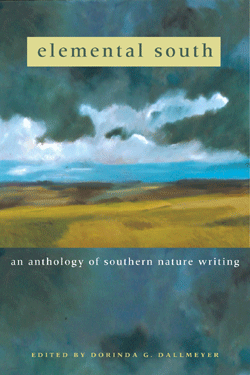
In 1929, botanist John Kunkel Small wrote a prophetic book about the impacts of development on the Florida landscape. Small, who had been collecting plants for the New York Botanical Garden for almost three decades here, was alarmed at how drainage and channelization were destroying the rare Florida that he loved. Without its vital wetlands, springs and rivers, the peninsula would eventually turn into a desert if trends continued, Small warned.
Out of print since 1929, this reprint is a valuable step in helping readers understand Florida's love-hate relationship with water. I was fortunate enough to work with an impressive group of professionals from the fields of science, graphic design, and publishing to make this book happen. Many of Small's original photos are included. Contact me for more info on this book, including ordering. (Cover photo of a sabal palm hammock on the lower Econlockhatchee River by Robert Boswell, M.D.)
Plans are now underway to use this book as way of explaining Florida's precarious water situation in a new Equinox Documentary.
BOOK REVIEWS & BLURBS about "SUNKEN CITIES"
Fom "Natural History" magazine, September 2004:
"Just about the time that you, dear reader, are pulling out of your driveway, heading for your daily aggression-filled hour on the expressway or inbound commuter train, Bill Belleville is probably tumbling backward off the gunwale of a diving boat into a crystal-blue ocean. An environmental journalist and filmmaker, Belleville has managed to make a decent living, as far as one can figure from these enjoyable essays, out of visiting ecologically engaging underwater sites in the West Indies and in Central and South America, and then writing about it for the folks at home. Nice work if you can get it.
It’s not all dog-paddling in a heated pool, though. Belleville is an expert diver whose wanderlust takes him to places few sane people would venture. In one early scene in the book he is dangling in a harness fifty feet above the water level of an overgrown limestone cenote, or sinkhole, deep in the jungle of the Dominican Republic. From that precarious position, a winch will lower him down to an inflatable raft floating on the shadowed waters far below. With a team of scuba-clad archaeologists, he will dive more than a hundred feet farther down into the cenote, to a pinnacle of rock that rises from the pit’s bottom (some 250 feet under water). From there, he and the rest of the team will get their bearings as they search for artifacts tossed into the sinkhole by pre-Columbian tribes as a sacrifice to their gods.
It’s cold, dark, and claustrophobic down there, with practically no margin for carelessness. But the journey, which leads to the discovery of shards of ancient pottery and the bones of extinct sloths, makes for a story of great suspense.
Equally chilling is Belleville’s account of a nocturnal dive off the coast of Cuba in search of the rarely seen, bioluminescent flashlight fish (Kryptophanaron alfredi). To spot its soft radiance, Belleville and a companion turn off their lamps before descending into near total darkness, aiming for an underwater cliff top. They can see neither their depth gauges, the research vessel above them, nor even one another. Except for the increasing crush of water pressure, the luminous flashes of the passing marine life, and the glow of their own ascending air bubbles (which roil the abundant plankton in the water), the effect is one of almost total sensory deprivation.
When Belleville finally pulls up, turns on his light, and looks at his digital wrist gauge, he finds that he’s dropped almost 110 feet, probably overshooting the target. For a tense ten minutes Belleville wanders around alone searching for his partner, whose light, if it’s on, is nowhere in sight. He’s afraid to swim very far in any one direction, terrified that, should he be forced to surface too far from the boat, he’ll be lost from sight, a helpless dot in the choppy waters that surround Cuba.
Fortunately for Belleville (and for readers with a low tolerance for stress), most of the brief excursions he describes in his book take place in far less threatening, though no less interesting, settings. Short essays describe travels to the interior of central Guyana, where rugged jungle and towering waterfalls become exotic destinations for ecotourism; to the ominously named Mosquito Coast of Nicaragua, where conservationists try to enlist native fishermen in a project to preserve endangered sea turtles; and to the Peruvian Amazon, where a team of biologists is studying the behavior of the boto, an unusual, pink, freshwater dolphin. Belleville’s account of the commercial conch farm he visits on one of the Turks and Caicos Islands, an archipelago southeast of the Bahamas, depicts an operation not unlike that of a Midwest cattle ranch—though the conchs, which look like foot-long garden slugs, are destined for soup pots around the Caribbean, not fast-food joints in Tulsa.
Yet such is Belleville’s talent that even when he ventures into relatively familiar territory, he brings an unfamiliar perspective, finding adventure and wonderment in little-seen corners of the natural world. In one episode he describes cave-diving on the Suwannee River in northern Florida, and rejoices in "the singular wonder of being inside the living veins of the earth." In another, he and a college friend take a canoe trip into the heart of the Everglades. There, only a few dozen miles from the strip malls and beachfront condos where former commuters go to live out their days, are worlds out of time: transparent channels filled with needlefish, lone ospreys gliding past tangled mangrove shores, flocks of sulfur-winged butterflies."
*************************************************************
""This collection of essays brings the reader to places that are noted for archaeological treasures, rare plants and animals, or great scenery, and water is the common denominator. Belleville, travel writer, scuba diver, and boater, seems always to be wet or preparing to be wet. As his armchair companions, readers may stay dry, but the expressive and descriptive prose allows them to experience the discovery and excitement as if they were there themselves. In the Amazon, the quest is for a freshwater dolphin. In the Florida Keys, it's the quiet backwaters that preserve the past, and so on, around the globe. Belleville is an old-fashioned adventurer, excited by what he finds, seeking just for the joy of finding. He must also be a man of great charm as he seems able to coax the most arcane information from his local guides...As a book to read at leisure, it is a fine treat."
-Danise Hoover, BOOKLIST, March 15, 2004
**********************************************************************
"Florida-based naturalist Bill Belleville journeys to one of the last travel frontiers: the underwater world. From the Gulf of Mexico to the Amazon, Belleville seeks out strange aquatic species and sunken archaeological sites. He witnesses the rare spawning of a coral reef. He introduces the freshwater pink dolphin, which Peruvian villagers believe to have magic powers. And he explores the underwater ruins of Port Royal, Jamaica, the "Pompeii of the Caribbean," swallowed by the sea during a 1691 earthquake.
These tales of adventure were originally published as magazine pieces and are crisply written in the you-are-there present tense. Belleville's writing is down to earth, with minimal jargon (one exception--he never defines precisely what a cenote is). He enlivens his prose with flashes of humor and indulges us urbanites with pop-culture analogies.
Water is not the only common theme flowing through these pieces. So is a love for unspoiled nature and an impatience with those who threaten it. Belleville has crafted each story to foster appreciation for the natural world.
- International Travel News, Sept, 2004 by Chris Springer
**********************************************************************
"I admire the precision, the poignancy and the passion of Bill Belleville's prose."
-Don George, LONELY PLANET Global Travel Editor
"What splendid adventures Bill Belleville guides us through! He is one of our great modern explorers, questing for gods in a time of technology, lusting for life. Here in this sensuous and unforgettable book he navigates us as deftly through language as he does Amazonian rivers or limestone fountains deep within the earth. His journey narratives are fluid, fresh, and piercingly poetic; what he finds is ceaselessly fascinating. I would travel with Bill Belleville to the ends of the earth."
-Janisse Ray, author of 'Wild Card Quilt: Taking a Chance on Home' & 'Ecology of a Cracker Childhood'.
"Bill Belleville's writing is like a stream of phosphorescence in the ocean that he loves so well. Belleville's language creates a dreamy double vision, blending archetype and precision so well that the reader is convinced he has not merely read about jeweled morays and pink dolphins, but floated alongside them in tropical waters. These tales are not hairy-chested, macho attempts to conquer snowcapped peaks, but adventures into sensuality and meaning."
- Susan Zakin, author of 'Coyotes and Town Dogs: Earth First! and the Environmental Movement'
"With the release of a new book, 'Sunken Cities,Sacred Cenotes and "Golden Sharks: Travels of a Water-Bound Adventurer,' Florida author Belleville is that much closer to solidifying his reputation as a top-shelf nature writer. As much adventure story as naturalistic poetry, Belleville's latest excels at wrapping his eco-prose in a captivating form. After all, who doesn't love reading about sunken treasure?
For Belleville, these treasures are both artifacts and living; he gives as much breathless attention to coral reproduction as he does to a now-underwater city. As with "Deep Cuba" (Belleville's last book, recently reissued in paperback), "Sunken Cities" is a book that tackles ecological and political problems in a way that's engaging simply as a stand-alone story."
- THE ORLANDO (Fla.) WEEKLY. May 7, 2004
"Bill Belleville is a fearless Florida scuba diver, explorer and underwater adventurer. He also is a heck of a writer. His poetic images in his latest travel tale, "Sunken Cities, Sacred Cenotes & Golden Sharks," not only engage the reader but elevate his work to a higher level than just another trek through the jungle.
Each of these chapters -- already run in magazines, which accounts for their brevity -- could be a book unto itself, but Belleville seems content to recall the moments leading up to each memorable dive, the dive and then the spiritual or philosophical rush he gets from the dive.
He meets a lot of interesting characters, as one would in the swampy backwoods of Florida or on the remote islands and rivers of the Caribbean Basin."
- Rebecca Thomas, Staff Writer, Covington (Ga) News. April 29, 2004
+++++++++++++++++++++++++++++++++++++++++++++++++++++
ENVIRONMENTAL WRITING: WHAT'S THE POINT? (A short rant)
The information superhighway can be a busy, congested place, and we're all trying to navigate it without becoming roadkill.
One of the best ways to navigate anything, I've found, is to simply slow down. I feel there's a lot of wrong turns made by going way too fast, by wanting to be somewhere else other than where we are at the moment.
The natural world helps me slow down. It's a bit like fly tying---the behavior itself affords a certain grace. It just doesn't allow us to rush through it. That's one of the reasons I've chosen to write about experiences that take place under the sky, on the water, deep in the woods somewhere. Learning about habitats and ecology---of people and place---is an abiding theme. But, really, it gives me the chance to spend a lot of time playing outside.
Like naturalist Aldo Leopold, I don't think we can really connect or care for a place unless we have a gut relationship with it. We're losing our natural lands at an alarming rate---especially in Florida where I live. Citizens who years ago might not have wanted to rock the boat now feel a need to speak up and express their concern over this loss. Maybe my books, articles and films might suggest how urgent it is to forge a connection with these places. But, anything I can say in way of advocacy is only rhetoric; it pales next to a personal experience a reader or viewer may have with a natural landscape.
Jim Harrison has written that the danger of civilization is that "We piss away our lives on nonsense." Web sites, books, films---they can only do so much. They are tools, honestly, ways to lead us to authentic and real places in the world. But if we obsess on them, they lose their context. And, it's a conceit to think that only writers or artists have an exclusive grasp on blazing trails to these places. Celebrity can be very seductive, both for the one being celebrated as well as for the ones engaging in the celebration. We can help read the maps and use the compass. But, the experience of finding your way to a rare place that affords redemption is yours alone.
So, after you make your way through this site---or maybe sometime before--- turn off your computer, go outside, and breathe deeply. Take a walk in the woods. Snorkel or scuba dive in a spring, a lake or river, an ocean. Paddle your canoe or kayak until you can no longer hear the hum of the mechanized world. Travel to a distant rainforest or reef and get to know the people whose lives are shaped by the wonder of it all. Or just sit under a tree and relax. Let our genetic predisposition for the natural world kick in. You don't need me or anyone else to preach to you about protection or preservation. You'll know what to do.
- Bill Belleville
_________________________________________________________________
